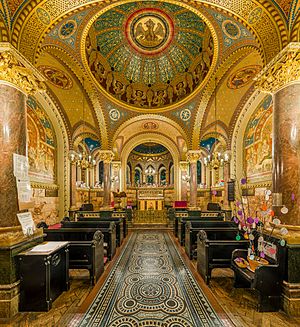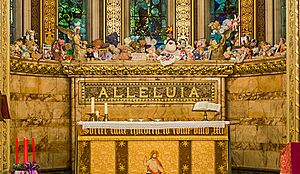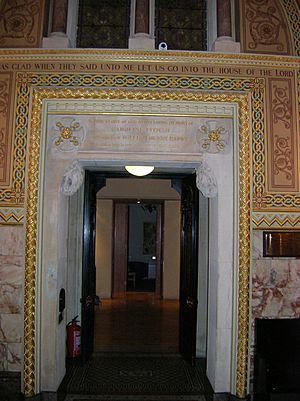St Christopher's Chapel, Great Ormond Street Hospital facts for kids
Quick facts for kids St Christopher's Chapel |
|
|---|---|

Interior of the chapel
|
|
| 51°31′20″N 0°07′16″W / 51.5222°N 0.121°W | |
| Location | Great Ormond Street, Bloomsbury, London |
| Country | England |
| Denomination | Anglican |
| History | |
| Status | Active |
| Dedication | Saint Christopher |
| Consecrated | 18 November 1875 by Alfred Barry |
| Architecture | |
| Functional status | Hospital chapel |
| Heritage designation | Grade II* |
| Designated | 10 March 1980 |
| Architect(s) | Edward Middleton Barry |
| Completed | 1875 |
St Christopher's Chapel is a special place inside Great Ormond Street Hospital in London, England. It is a chapel, which is a small building or room used for Christian worship. This chapel is very important because it is a grade II* listed building. This means it is a historic building that needs to be protected. People especially notice its beautiful and highly decorated inside.
Contents
History of the Chapel
The chapel was finished in 1875. It was part of the larger Great Ormond Street Hospital which was built between 1871 and 1876. The person who designed the chapel was an architect named Edward Middleton Barry. He gave his work for free to the hospital. He did this to remember one of his own children who had passed away when they were very young. Building the chapel cost a lot of money, about £60,000 back then.
The chapel is a small, rectangular building. It has a rounded end called an apse at its eastern side. The inside of the chapel is very fancy and decorated with many beautiful details. On November 18, 1875, the chapel was officially opened and blessed. This ceremony is called a consecration. It was done by Canon Alfred Barry.
A Building That Moved
Because the chapel is a grade II* listed building, it could not be knocked down. This became important in the 1980s when the old hospital building was being taken down. Instead of destroying it, they decided to move the entire chapel to a new spot!
To do this, workers put the whole chapel inside a big, waterproof box. They also added a strong concrete base underneath it. First, they took out all the furniture and the beautiful stained-glass windows from inside. Then, the chapel, still in its box, was carefully lowered from the first floor to the ground. After that, powerful machines called hydraulic rams slowly pushed it to its new location. This was a huge job! It is thought to be the biggest time a building has ever been moved all in one piece.
After six years of moving and fixing up, the chapel was ready again. It was reopened on February 14, 1994, by Diana, Princess of Wales.
The Chapel Today
Today, the chapel is always open. People can visit it at any time. There are also regular services held there. For example, there is a morning prayer service from Monday to Friday. On Wednesdays, there is a Holy Communion service.
One special thing you will see in the chapel is a row of teddy bears and other soft toys. These toys are placed behind the altar by families of children who are sick at the hospital. They are known as the "Teddy Bear Choir." The chapel also has a prayer tree. On this tree, people can write messages of hope and support for the children. They then hang these messages on the tree.
Inside the Chapel
The inside of St Christopher's Chapel looks like a mix of French and Italian styles from the Renaissance Revival period. It has four columns that divide the space. In the middle, there is a central dome. The eastern end has the rounded apse.
The floor is made of terrazzo, a type of flooring with chips of marble or other materials. It was designed by an Italian artist named Antonio Salviati. People say his design was inspired by a famous floor in St Mark's Basilica in Venice, Italy.
The chapel's interior is very detailed and decorated. Many of the pictures and designs inside are about childhood. The central dome has paintings of angels playing music around its edge. In the very center of the dome, there is a picture of a pelican. The windows in the apse are made of stained-glass. They were designed by a company called Clayton and Bell. These windows show scenes from the childhood of Jesus Christ. The ceiling of the apse has eight angels painted on it. Each angel represents something like Faith, Truth, or Hope. In the middle of these angels, there is a round picture of the Lamb and flag.
You can also find many Bible quotes painted on the walls with pictures next to them. For example, one quote says, "Suffer little children to come unto me." Another one says, "feed my lambs + feed my sheep." Above the main door, it says, "I was glad when they said unto me let us go into the House of the Lord."
Important Memorials
The walls of the chapel have several memorial plaques. These plaques remember important people connected to the hospital. Some of these people include:
- Sir J. M. Barrie (1860–1937): He was a famous writer who created Peter Pan. In 1929, he gave all the rights to his Peter Pan works to Great Ormond Street Hospital. This means the hospital gets money from Peter Pan to help sick children.
- William Henry Barry (1823–1880): He was the person who gave money to build and support the chapel.
- Charles Dickens: He was a well-known author. He also helped raise money for the hospital when it was first starting.
- Lt Col Alexander Simpson-Smith (1900–1942): He was a surgeon at the hospital. During World War II, he joined the British Army. He passed away in Egypt in 1942 while serving.



